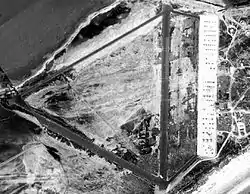Matagorda Peninsula Army Airfield
Matagorda Peninsula Army Airfield is a closed military airfield, located on Matagorda Island, Texas. It was used during World War II as a training airfield by the 77th Flying Training Wing, Army Air Forces Central Flying Training Command.
| Matagorda Peninsula Army Airfield | |||||||||||||||
|---|---|---|---|---|---|---|---|---|---|---|---|---|---|---|---|
| Near Matagorda Island, Texas | |||||||||||||||
 March 1943 photo showing over 100 aircraft on the Matagorda Peninsula AAF ramp. | |||||||||||||||
 Matagorda Peninsula Army Airfield Location of Matagorda Army Airfield | |||||||||||||||
| Coordinates | 28°27′17″N 096°17′54″W | ||||||||||||||
| Site information | |||||||||||||||
| Condition | Abandoned | ||||||||||||||
| Site history | |||||||||||||||
| Built | 1942 | ||||||||||||||
| In use | 1942-1945 | ||||||||||||||
| Battles/wars | World War II | ||||||||||||||
| Garrison information | |||||||||||||||
| Garrison | |||||||||||||||
| Occupants | AAF Pilot School (Advanced Single Engine Transition) 77th Flying Training Wing | ||||||||||||||
| Airfield information | |||||||||||||||
| |||||||||||||||
History
World War II

The airfield was built during 1942 by the Army Air Corps, primarily to support the Matagorda Bombing Range. In addition it was also developed as a training school by Army Air Forces Training Command. Matagorda AAF was the home of the AAF Pilot School (Advanced Single Engine), and also conducted a Single-Engine Pilot Transition school.[1] The major military units assigned were the 62d Single Engine Flying Training Group and 79th Bombardier Training Group.[2]
Initially built with three runways, during the war two additional runways were added to accommodate the large number of landings and takeoffs. Aircraft assigned to the base were North American AT-6 Texans, Curtiss P-40 Warhawks, Republic P-47 Thunderbolts, and North American P-51 Mustangs.[3] A series of curved roads on the east side of the parking ramp had dozens of buildings. After the war ended, the training school was inactivated and the facility was closed in November 1945.[1]
Civil use

SSIA was purchased by EER Systems in December 1990. The design was modified again, this time using Castor engines like those used on the Scout, a workhorse of the 1960s. The new design was known as the Conestoga with a four-digit number following it indicating the arrangement of the boosters.

After the war ended, the airfield was transferred to civil control, and was known as Matagorda Peninsula Airport. In the late 1940s, the National Advisory Committee for Aeronautics considered Matagorda Island as a rocket launch site, however, Cape Canaveral, Florida was chosen instead. However, in the 1980s, a private firm, Space Services Inc. established a rocket launch facility on the island for commercial rockets with the airport, known was Pierce Field, providing aircraft access.[1]
The airfield remained active until about 2002 when Space Services ended its use of Matagorda Island, and the airport was closed and abandoned.[1]
Today, the airport is closed and its facilities are deteriorating. Some old rocket launch stands can be found in the area. The World War II military base was dismantled and no longer remains.
See also
References
![]() This article incorporates public domain material from the Air Force Historical Research Agency website http://www.afhra.af.mil/.
This article incorporates public domain material from the Air Force Historical Research Agency website http://www.afhra.af.mil/.
- "Abandoned & Little-Known Airfields: Texas, Northeastern Corpus Christi area". Archived from the original on 2014-03-21. Retrieved 2014-03-20.
- 77th Flying Training Wing, lineage and history document Air Force Historical Agency, Maxwell AFB, Alabama
- www.accident-report.com: Matagorda Peninsula Bombing Range Archived 2014-10-08 at the Wayback Machine
